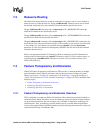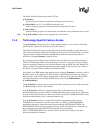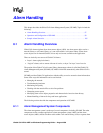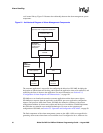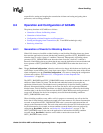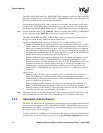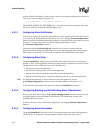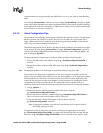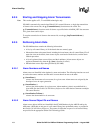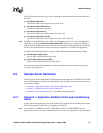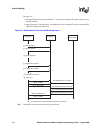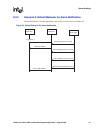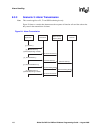
Global Call API for HMP on Windows Programming Guide — August 2006 101
Alarm Handling
In addition, the alarm source object must meet the alarm flow configuration requirements, which
are set using the gc_SetAlarmFlow( ) function or the gc_NotifyAll( ) function. (See Section 8.2.3,
“Configuration of Alarm Properties and Characteristics”, on page 101 for more information.)
When the application returns a GCEV_ALARM event, indicating that an alarm has been received,
information about the alarm can be retrieved using the gc_AlarmName( ) function. The
gc_AlarmName( ) function converts the alarm to its text name to allow for interpretation of the
reason for the alarm. For more information on retrieving alarm data for a given ALARM_EVENT,
see Section 8.2.5, “Retrieving Alarm Data”, on page 104.
Some of the ways the information provided by the GCEV_ALARM events can be used are:
• Administration of alarms (using alarm information to determine the appropriate configuration
of GCAMS)
• Detection and transmission of alarm conditions between networks (drop and insert
applications)
• Manual handling of alarms for drop and insert applications
• Generating reports
• Troubleshooting connections and protocols
8.2.3 Configuration of Alarm Properties and Characteristics
GCAMS provides the ability to set the alarm configuration for line devices and alarm source
objects. The initialization of ASO configuration values is done at build time.
The Global Call API provides several functions that are used to configure how, when and which
alarms are sent to the application, and to define the characteristics of the alarms. These functions
are:
• gc_SetAlarmConfiguration( )
• gc_SetAlarmFlow( )
• gc_SetAlarmNotifyAll( )
• gc_SetAlarmParm( )
Corresponding functions allow for the retrieval of the current status of the configurations. These
functions are:
• gc_GetAlarmConfiguration( )
• gc_GetAlarmFlow( )
• gc_GetAlarmParm( )
The use of these functions is described in the following sections. Alarm configuration tips are also
provided. For more information about the alarm configuration functions, see the Global Call API
Library Reference.
For line devices opened by technologies that use GCAMS, there is an entity called the network
ASO ID that is the alarm source object associated with the network. As a programming
convenience, Global Call defines ALARM_SOURCE_ID_NETWORK_ID that corresponds to the



